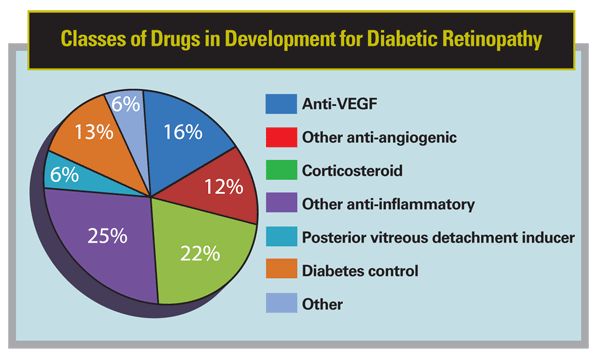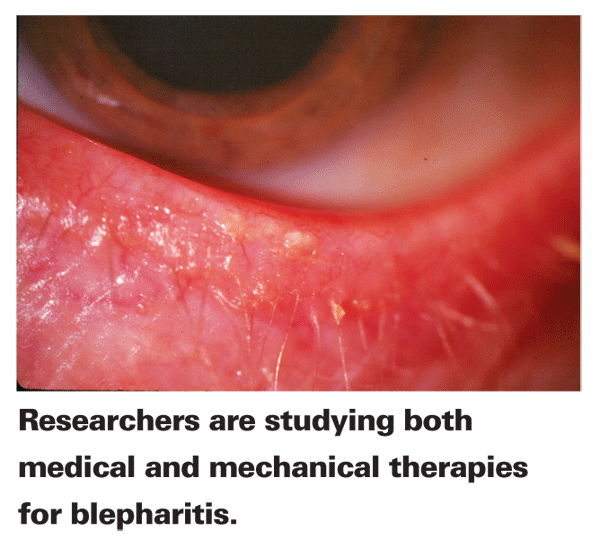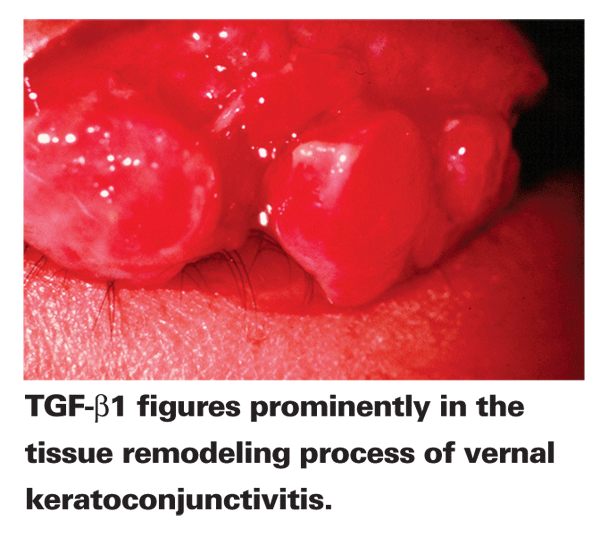This year's annual gathering of the Association for Research in Vision and Ophthalmology in
Retina
• Age-related macular degeneration. Retinal diseases, especially AMD, have remained a popular topic of ARVO posters and papers. In AMD clinical research, Regeneron has continued work on its VEGF Trap-Eye, a fusion protein that binds to all vascular endothelial growth factor-A isoforms and placental growth factor. Results from the 12-month Phase II study by the CLEAR-IT 2 investigators in neovascular AMD (n=157) demonstrate that the drug lowers central retinal thickness, total macular volume and choroidal neovascularization compared to baseline values at one year. (Slakter J, et al. IOVS 2009;50:ARVO E-abstract 1890) Patients given VEGF Trap-Eye had a mean increase in best-corrected acuity of 5.3 letters (Heier J, et al. E-abstract 1255) along with improvements in patient-reported vision-specific quality of life as assessed by the NEI-VFQ 25. (Do D, et al. E-abstract 1887) Predictive factors of greater visual acuity gains with VEGF Trap-Eye included older age (BCVA increase of 8.26 letters) and worse baseline visual acuity (7.54 letters). (Heier J, et al. E-abstract 1255)
In pre-clinical AMD studies, researchers at Alcon Laboratories found that application of a serotonin agonist (AL-8309A) produced a dose-dependent reduction in oxidative damage and apoptosis induced by cytotoxins in a human retinal pigment epithelium cell line. Treatment with AL-8309 caused an upregulation of Mek 1/2 and Erk 1/2 phosphorylation, and a subsequent rise in anti-oxidant and anti-apoptotic proteins in RPE cells. These findings will lead to further examination of the potential role of serotonin agonists, which could be a novel class of AMD drugs. (Rhoades K, et. al. E-abstract 677)
• Diabetic retinopathy. A time trend analysis confirmed that diabetic retinopathy in patients with either type 1 or type 2 diabetes is still a major concern, and has not decreased in prevalence over the past 30 years. (Tzekov R, et al. E-abstract 4425) There is no shortage, however, of research into new therapies. Our group analyzed the publicly available literature on ongoing or recently conducted clinical trials for diabetic retinopathy and subdivided the data based on indication (non-proliferative diabetic retinopathy, panretinal photocoagulation and diabetic macular edema). Of the 57 identified trials, 85 percent were for DME and PDR, reflecting the slow and costly nature of NPDR trials. Most of the agents in development are repurposed systemic therapeutics, of either the anti-angiogenic or anti-inflammatory class. It's thought that the slow progression of diabetic retinopathy may explain the limited success of several of the recent Phase III trials. (Byrnes M, et al. E-abstract 83)

In a six-year, open-label extension study of Ruboxistaurin (RBX, Eli Lilly) led by an Eli Lilly researcher, 32 mg/day of RBX significantly reduced the incidence of sustained moderate vision loss despite a cessation of treatment (median interval: 466 days) following the initial study, which showed minimal efficacy. (Sheetz M, et. al. E-abstract 4330) In the original study, 5.5 percent of patients in the treatment group showed a 15-letter or greater decline in visual acuity compared to 9.1 percent of the placebo group.1
Treatment in the extension study, by contrast, showed much more promising results with 8 percent of patients in the treatment group experiencing sustained vision loss compared to 26 percent of patients on placebo. Thus, RBX may have a long-term protective effect not evident in the initial three-year study.
• OCT imaging. Another noteworthy and rapidly evolving area of research involves the use of optical coherence tomography. A collaboration between investigators from the National Eye Institute and Carl Zeiss Meditec found that Zeiss' new Cirrus High Definition OCT system could quantify photoreceptor outer segment (PROS) length in patients with diabetic macular edema. The investigators found a statistically significant correlation between outer segment length and visual acuity, suggesting that PROS length may be a useful outcome measure for clinical trials. (Forooghian F, et. al. E-abstract 1388)
Researchers from
Dry Eye
• Understanding dry eye. Researchers and clinicians recognize a multitude of etiologies and pathophysiologies of dry eye, but also remain in a constant struggle to pinpoint exact mechanisms involved. Research at ARVO delved into several intriguing topics potentially linked with dry eye, including the effects of different environmental situations (e.g., the
• Dry-eye endpoints. Visual function research included data evaluating the visual function effects of artificial tears using the Inter-blink interval Visual Acuity Decay test, developed here at our research group, Ora Inc. The IVAD test presents a quantitative measure of the visual acuity decay that occurs between a patient's blinks, and the ability of treatment to extend visual acuity maintenance between blinks holds substantial value given the quality-of-life implications of decay in visual function. (Torkildsen G, et al. E-abstract 4649) Findings on the correlation between symptomatic breakup time and corneal sensitivity demonstrate that patients with lower corneal sensitivity report awareness followed by discomfort later after a blink than normals, and suggest potential neural loop problems in this population. (Abelson M, et al. E-abstract 4675) Another poster from our research group investigated the influences of exposure to the Controlled Adverse Environment on the five established tear-film breakup patterns (TFBUPs): linear; wispy; spotting; fractured and amorphous blob. The results demonstrated that the linear TFBUP was the most prominent in eyes post-CAE exposure, and that the greatest decrease in tear-film breakup time after CAE exposure occurred in the linear group compared to all other groups (in eyes that changed after CAE exposure). These results support prior research demonstrating more severe signs and symptoms of dry eye in eyes displaying the linear pattern. Furthermore, they demonstrate the dynamic response of the tear film when exposed to an adverse environment (observable by TFBUP), and suggest that these alterations may provoke changes in the protective mechanism of the tear film. The use of TFBUP assessment as a means of identifying responders and evaluating therapies for dry eye warrants further investigation. (Ousler G, et al. E-abstract 522) Other endpoints presented included the revival of tear ferning, when researchers presented findings of the repeatability of the test in healthy subjects. The tears collected from 69 percent of subjects displayed identical ferning patterns in all five drops analyzed. (Masmali A, et al. E-abstract 543)
• Dry-eye treatment. Several exciting developments in the treatment of dry eye were also revealed, ranging from artificial tears to naturally occurring glycoprotein lacritin to RNAi technology for dry eye-related ocular pain. Highlights included a novel NGF peptidomimetic agent, MIM-D3, being developed by Mimetogen Pharmaceuticals. One company-supported presentation illustrated the secretagogue potential of MIM-D3 through its concentration-dependent induction of glycoprotein secretion in rat conjunctival goblet cell culture in vitro and significant twofold increase in tear mucin concentration in normal rats in vivo. (Meerovitch, et al. E-abstract 4261) A second Mimetogen poster presented findings that topical instillation of 10 mg/mL MIM-D3 in a rat model of scopolamine-induced dry eye for 17 days demonstrated a statistically significant decrease in corneal staining vs. vehicle (p<0.001), which correlated with a significant increase in mucin secretion in the tear fluid of treated animals vs. controls (p<0.05). (Li R, et al. E-abstract 3661)
Resolvins, lipid mediators generated through the oxidation of omega-3 fatty acids, are also an interesting therapeutic avenue. Research on resolvins supported by Resolvyx Pharmaceuticals demonstrated the ability of RX-10001 (RvE1) and RX-10008 to increase human corneal epithelial cell migration, (F Zhang, et al. E-abstract 3492) and included the potential applications for autoimmune ocular disease and ARMD. (Gjorstrup P, et al. E-abstract 819; Zhou Y, et al. E-abstract 2965; Sheets K, et al. E-abstract 2967) In addition, preclinical results of a selective glucocorticoid receptor agonist from Bausch & Lomb (BOL-303242-X) demonstrated equivalent overall efficacy as dexamethasone in a rabbit dry-eye model. (López F, et al. E-abstract 3662)
Lid Margin Disease
Intimately connected with dry eye, lid margin disease has grown to be its own category of ophthalmic research. Presentations on lid margin disease varied from intriguing research on animal models to treatment techniques that included an invasive intraductal probe to relieve symptoms of meibomian gland dysfunction.
One intriguing study from Australia's University of Western Sydney and Stanford University attempted to provide an explanation for the impressive tear-film stability of the koala—who reportedly blinks once every 10 minutes or so. Their findings could lead to further understanding of the alterations to meibomian secretions in lid margin disease.
The report demonstrated the physicochemical tendency of koala meibomian lipids to organize into a viscoelastic gel, representing a substantial difference from human lipids and potentially translating to future treatment approaches to lid margin disease. (Raju S, et al. E-abstract 4252)

James McCulley, MD, and his colleagues at the University of Texas Southwestern Medical Center presented data exhibiting the retarding effects of meibomian gland expression on tear evaporation lasting approximately 12 minutes post-digital expression. (McCulley J, et al. E-abstract 4635) Researchers also presented data of statistically significant improvements from baseline symptoms and TFBUT in women aged 40 to 60 years when treated with 5% testosterone cream b.i.d. Interestingly, no statistically significant changes were observed in women under 40 years of age or those over 60 years, which could indicate the role of menopause and age in meibomitis therapy. (Connor C, et al. E-abstract 4656)
One poster from Inspire Pharmaceuticals used a new method of evaluating treatment in chronic blepharitis patients. The study found that a four-week treatment with azithromycin ophthalmic solution 1% resulted in improvement in signs and symptoms of blepharitis as assessed using the Ora blepharitis scales. (Touhey D, et al. E-abstract 2661)
Ocular Anti-Infectives
• Treating ocular infection. Some of the most exciting anti-infective data presented pertained to research on Bausch & Lomb's besifloxacin, a novel ophthalmic fluoroquinolone that has no previous systemic use. In one study from B&L, following five days of t.i.d. treatment, besifloxacin ophthalmic suspension 0.6% achieved clinical cure rates of 58.3 percent at visit two (day 5 ±1) and 89.3 at visit three (day 8 or 9) in treated eyes of pediatric patients (n=84), compared to 47.4 percent at the second visit and 75.6 percent at the third visit in vehicle-treated eyes (n=78). Furthermore, microbial eradication was seen in 81 percent at the second visit and 76.2 percent at the third visit of besifloxacin-treated eyes vs. 51.3 percent and 65.4 percent of vehicle-treated eyes at each respective time point. (Comstock T, et al. E-abstract 2667)
Integrated results of three randomized clinical trials in patients with culture-confirmed bacterial conjunctivitis demonstrated 92.2 percent microbial eradication at visit two. The agent also demonstrated an impressive pharmacokinetic profile, including activity against drug-resistant isolates such as methicillin-resistant Staph aureus. (Morris T, et al. E-abstract 5945)
• Avoiding endophthalmitis. Another interesting topic was that of strategies to reduce the risk of endophthalmitis. Emily Gower, PhD, of Johns Hopkins presented a case-controlled study of the risk factors of post-cataract surgery endophthalmitis in a study of Medicare beneficiaries undergoing surgery during the year between 2003 and 2004. The findings suggested that intracameral antibiotic injection and antibiotics in the irrigating solution may be associated with decreased risk of postop endophthalmitis. (Gower E, et al. E-abstract 1245) Another presentation, this one supported by Alcon, demonstrated the potential antimicrobial benefit of soaking intraocular lenses in moxifloxacin 0.5%. (Shaw J, et al. E-abstract 2901)
Uveitis
Uveitis treatment is typically trial-and-error, but this year's meeting included results of several prospects for monotherapy. Mycophenolate mofetil—an immunosuppressant ultimately preventing replication of T and B lymphocytes that's used to prevent organ rejection following transplantation—was presented as one option for monotherapy. In a retrospective case series of MMF in pediatric uveitis patients, 48.1 percent of them remained free of inflammation without the need for long-term corticosteroid therapy for more than two years, 17.3 percent of patients achieved inflammation control on MMF treatment for a mean of 13.1 months and 7.7 percent achieved inflammation control for 6.8 months, but had to discontinue due to substantial adverse effects. Additionally, 94.2 percent of the entire patient population either maintained or improved their acuity. The most common adverse events were generally mild in comparison to those experienced with other immunomodulators for uveitis, and consisted of gastrointestinal disturbances (21 percent), fatigue (12 percent) and leukopenia (10 percent). (Chang P, et al. E-abstract 2680)
In another study, results of MMF therapy in patients with non-infectious ocular inflammation also demonstrated good tolerability and efficacy in the setting of anterior uveitis and mucous membrane pemphigoid. (Daniel E, et al. E-abstract 2679)
Glaucoma Treatment
Overall, many preclinical findings were presented on several exciting pipeline products for the management of glaucoma. Researchers presented data on the effects of topical dosing with a selective rho kinase-inhibitor developed by Aerie Pharmaceuticals (0.6% AR-12286) in normotensive eyes of monkeys. The study, partially sponsored by Aerie, demonstrated a 19-percent reduction in intraocular pressure from baseline, which was theorized to be related to an increase in tonographic outflow facility. (Wang R, et al. E-abstract 1465)
A Pfizer-sponsored trial in monkeys with unilateral glaucoma demonstrated that another pipeline treatment, Pfizer's prostanoid EP4 receptor agonist (PF-04475270), resulted in similar IOP reduction to latanoprost six hours post-dose, and IOP reduction persisted for up to 24 hours after a single dose. (Fan S, et al. E-abstract 812) In normotensive beagles, Pfizer researchers found that topical administration of PF-04475270 lowered IOP by a maximum of 30 to 45 percent relative to vehicle-treated eyes at 24 hours post-dose, while maximum IOP reduction of latanoprost was 20 percent relative to vehicle at 12 to 18 hours post-dose. (Prasanna G, et al. E-abstract 1466)
Pfizer research on another pipeline product, the nitric oxide donating prostaglandin analog PF-3187207, demonstrated IOP reduction across three hypertensive animal models: cynomolgus primates with laser-induced hypertension; glaucomatous beagles and rabbits with ocular hypertension induced by intracameral administration of hypertonic saline. (Krauss A, et al. E-abstract 1471)
Other agents of note: Researchers affiliated with Danube Pharmaceuticals presented preclinical study results for the company's ion channel modulator, DNB-001 (Serle J, et al. E-abstract 1474); Speedel Experimenta discussed results of its endothelin antagonist SPP 301 (Podos S, et al. E-abstract 1476); and Sylentis researchers delved into their company's siRNAs for glaucoma. (Jimenez A. E-abstract 4054) It will be very interesting to observe these unique treatment approaches as they progress.
Understanding Ocular Allergy
Epidemiology was a notable theme in the allergy presentations. Colleagues of ours here at Ora evaluated the pattern of the signs and symptoms of allergic conjunctivitis in an untreated allergic patient population for four weeks during ragweed season. Subjects completed questionnaires and diaries to capture an accurate picture of their symptomatology, and the researchers recorded environmental factors such as rainfall and pollen counts. The patterns of pollination corresponded to patients' allergic reactions. Symptoms attenuated with increased rainfall. Time of day also had a large impact, with symptoms being worse in the morning. (Plumer A, et al. E-abstract 2701)
The frequency of skin reactivity in tandem with allergic conjunctivitis in allergy patients was also studied at this year's meeting. Researchers from

There were also several studies concerning tear and serum dynamics. Serum IgE levels were evaluated in allergic conjunctivitis versus contact lens wearers, and results demonstrated that there is a statistically significant correlation between contact lens wear and serum IgE levels. (Gurses O, et al. E-abstract 6321) Peptide characterization was the subject of another study that identified upwards of 50 new peptides; some, however, are quite small (below 6,000 da) and their importance as biomarkers is yet to be established. (Bortolotti M, et al. E-abstract 6331)
Two studies presented data in support of the prominent role of TGF-b1 in the tissue remodeling process of vernal keratoconjunctivitis. (Ohtomo K, et al. E-abstract 6317; Motterle L, et al. E-abstract 6318). Another study explored corneal sensory nerve stimulation during the progression of allergic conjunctivitis and found that shifts in the incidence of spontaneous versus stimulus-evoked activity over time may contribute to hypersensitivity and discomfort. (Ascosta M, et al. E-abstract 6322)
Some posters focused on the safety or efficacy of various therapeutic agents.
Researchers evaluated preservative-free, cromolyn sodium 4%-chlorpheniramine maleate 0.2% (Visuglican) for its ability to reduce signs and symptoms of allergic conjunctivitis as well as its effect on neuropeptide levels in tears. (Micera A, et al. E-abstract 6316) Cyclosporine 0.05% was evaluated for tolerability as well as efficacy in reducing seasonal relapses of vernal keratoconjunctivitis compared to the antihistamine ketotifen 0.025% in a six-month environmental study. (Lambiase A, et al. E-abstract 6326)
Three posters concentrated on the safety or efficacy of the new topical antihistamine bepotastine besilate 1.5% (Bepreve) ophthalmic solution. Researchers evaluated bepotastine for safety in a pediatric population (Protzko E, et al. E-abstract 6325), and other posters specifically evaluated its efficacy in reducing ocular itching (Macejko T, et al. E-abstract 6328) and tearing (Kurata F, et al. E-abstract 6324) for at least eight hours.
The researchers from the three posters received support from Ista.
Finally, scientists at Bausch & Lomb and a group of Italian researchers evaluated the selective glucocorticoid receptor agonist BOL-303242-X for its effect in repressing cytokine expression in eosinophils and mast cells, as well as in reducing symptoms of allergic conjunctivitis compared with dexamethasone in guinea pigs (Bucolo, E-abstract 6323).
Once again, ARVO proved to be a prime venue of research, and we eagerly anticipate the progress to be presented at ARVO 2010!
Dr. Abelson, an associate clinical professor of ophthalmology at
Dr. Abelson would like to thank the following staff for their contributions to the article: Donna Welch, RN, BSN, Radouil T. Tzekov, MD, PhD, George W. Ousler III, Aron Shapiro, Paul J. Gomes, MS, Ciera J. Maffei, Amanda J. Howe, Dan Dewey-Mattia and Lauren Lilyestrom.
1. Aiello LP,



